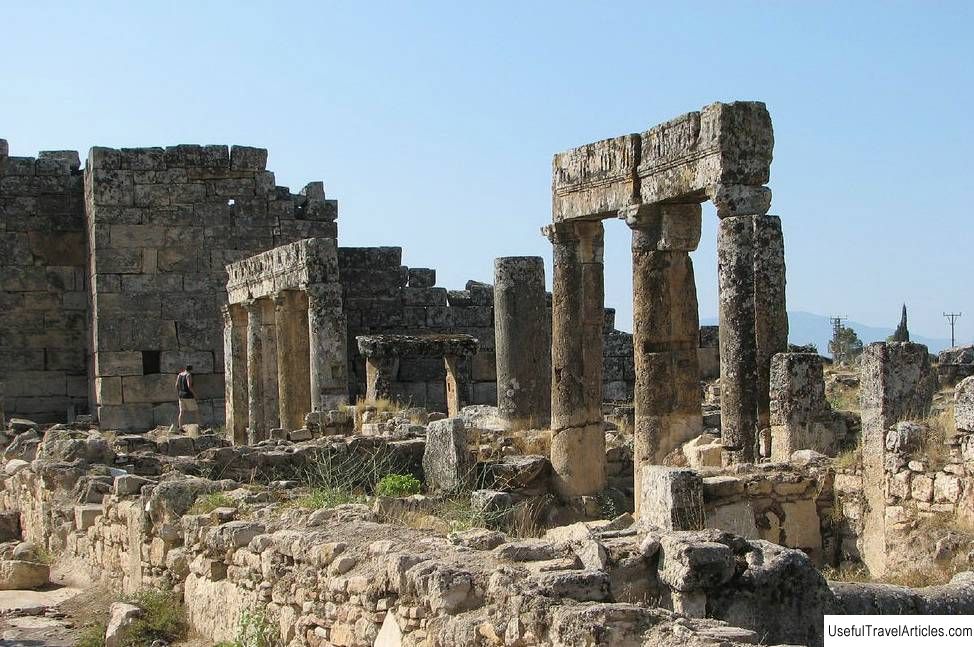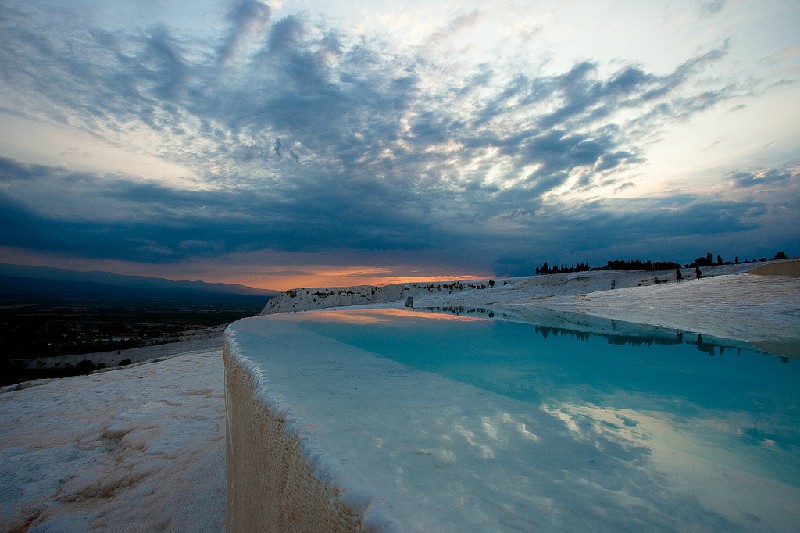Hierapolis description and photos - Turkey: Pamukkale
Rating: 9,2/10 (4653 votes) 
Hierapolis description and photos - Turkey: Pamukkale. Detailed information about the attraction. Description, photographs and a map showing the nearest significant objects. The name in English is Hierapolis. Photo and descriptionThe ruins of the ancient city of Hierapolis, or the “Holy City” associated with the name of the holy Apostle Philip, are located about 17 kilometers from the provincial Turkish town of Denizli. They are located on a mountain elevation, which is 350 meters high. The first structures appeared here in the second millennium BC. In 190 BC, a new city was built here by King Eumenes II of Pergamum. Sixty years later, Hierapolis became part of the Roman Empire, and at the beginning of our era it was severely destroyed by an earthquake. In the 60s of the first century, the city was rebuilt again and became known as a resort. Later, Hierapolis passed under the rule of Byzantium, then was under the leadership of the Turkish sultan. Earthquakes happened quite often here, and in 1534 one of them almost completely destroyed the city. This place was forgotten until the end of the nineteenth century, when the first excavations began here. Now the ruins of ancient Hierapolis are located on the territory of the modern Turkish resort of Pamukkale and are very popular among tourists. Here you can get acquainted with the ancient history and see the architectural masterpieces of those times. One of the most significant sights of Hierapolis is the ancient theater, located on the hillside. The building was the third largest after the theaters of Ephesus and Aspendos. Its construction began in the first half of the 2nd century and already in the 3rd century the structure was significantly expanded. The building was erected from solid stones and the total height of its steps is about one hundred meters. Fifty rows divided by aisles into seven sectors are seats for spectators. The amphitheater is divided into two tiers and there are arched passages on either side of it. Among the spectators' seats, exactly in the center, is the imperial box. The stage of the theater is located at a height of more than three meters and is decorated with magnificent stucco moldings with images of Artemis, Apollo, Dionysus. In the back of it there are original bas-reliefs and three rows of columns, the space between which is occupied by sculptures. The bas-reliefs depict revered gods and mythological heroes and differ in style because they were made by skilled craftsmen from different eras. After the completion of construction, the theater could accommodate about ten thousand people. Pamukkale hosts the July International Music Festival every year, using an ancient theater. True, now on its 46 rows only about seven thousand spectators fit. The Temple of Apollo was erected in Hierapolis in the third century BC. It was the largest sanctuary in the polis, but unfortunately, now all that remains of it is a wide multi-step staircase leading to the foot of the temple, and a platform in front of the structure, which is surrounded by a protective wall. According to legend, the temple was destroyed by an earthquake that occurred at the time of the crucifixion of the holy Apostle Philip. On the southern side of this ancient building is a place that is considered the abode of the ruler of life and death, Pluto, the Roman god of the underworld. It is a small, almost imperceptible crack in the ground, which is enclosed by a stone case. It is believed that sharp and intense vapors and gases coming out of it are so poisonous, that birds and small animals die from them. This property of this crevice was used by the priests in ancient times to convince people that they communicate with the gods. When believers came for predictions, & nbsp; the priest asked the god Apollo to kill the bird as proof of his strength and released the bird into the cave. The bird poisoned with carbon dioxide died, which was a confirmation of the connection of the priests with the deity. Earlier, the entrance to Pluto's grotto was open, but after the terrible tragedy that happened to the German tourists, the entrance was closed with an iron grating. Travelers suffocated in the sacred niche and now it is inaccessible for visiting. Among the monuments of Hierapolis dating back to the Roman era, the Arch of Domitian should be noted. This majestic gate is the entrance to the ancient city and was erected in the first century by Julius Frontinus, proconsul of the Anatolian province. Passing through them, the traveler immediately found himself on the spacious central street, the width of which was approximately 14 meters. The street crossed the entire city and ended at the southern Roman gate, behind which the road to Laodicea began. It is known that in ancient times the gates were two-story. Nowadays, you can admire the good state of preservation of the first floor of one of the two round towers, which were built of large stones and connected by three high arches. As soon as the traveler passes through the Frontino gate, he sees a small Byzantine church on the left built from previously used materials. On the floor of the temple was found a marble altar and a semblance of an icon made on a piece of marble slab. It is assumed that the church was dedicated to the protector of travelers, the Virgin Hodegetria. Before the entrance to the church there used to be a rectangular visor, and under it was a plate with the image of Apollo, the patron god of the city of Hierapolis. The length of the city's main street, dividing it into two halves, is approximately equal to a kilometer. Galleries and important public buildings were built on both sides. The slabs in the central part of the main street still cover the canal lined with narrow limestone slabs. It is he who is the city sewer system. It is known that previously there was a bathhouse in front of the city gates. Thus, it was possible to enter the city only after thoroughly washing. The martyric temple of Saint Philip was built in Hierapolis in the 4th century. It is believed that the church was erected on the site of the death of the apostle. The temple had an octagonal shape and its diameter was 20 meters. The church had a central room in which, according to legend, the tomb of St. Philip was located, but to date it has not been found. The dome of this room was made of wood and covered with lead, while the rest of the roof of the temple was wooden. The base of the structure is in the form of a double cross. The temple had a beautiful chapel and a terrace with several rooms, of which only the ruins of the walls remained. The city of Hierapolis was repeatedly subjected to earthquakes, the last of which almost completely destroyed the martyria temple. Nevertheless, it can still be viewed using the wide staircase located outside. In Pamukkale, the Feast of St. Philip is held every November. After the assassination of St. Philip, the city began to be called the Holy City, and the Church of St. Philip is one of the most important places of pilgrimage for Christians. Hierapolis is home to one of the largest necropolises of Asia Minor of the era of Hellenism, Rome and early Christianity, which from all sides approaches the walls of the city. Even in ancient times, a huge number of patients flocked to Hierapolis, famous for its thermal springs, hoping for healing. Many of them, having coped with the disease, returned home, while others, dying, remained here forever. This explains the enormous size of the local Necropolis. In addition, the dead in Hierapolis were buried according to their traditions, therefore, the cemetery is distinguished by an extraordinary variety of burial monuments and tombstones, among which there are sarcophagi, typically Lycian graves, family crypts, etc. The length of the necropolis is two kilometers and it is conventionally divided into two parts: southern and northern. The necropolis contains very impressive burial structures, with a strong foundation made of stone blocks, arched arched ceilings and the remains of columns. Some of the burials here are very modest, made of stone, the graves of commoners. Although there are those that amaze with their size, shape and originality of the decor. The oldest Greek burials are made in the form of round barrows, which were common in Anatolia in the second and first centuries BC. There are various sarcophagi, marble or limestone, with flat or gable lids, with or without interesting decor, placed on stone foundations or dug into the ground. There are also family crypts dedicated to several sarcophagi. Of the 1200 burials, about 300 are equipped with epitaphs giving the name of the deceased, his occupation, as well as mentioning the deeds for which he became famous. The most famous burial of the northern necropolis is the tomb of Titus Flavius, often called the grave of the traveler. It is located to the right of the main city gate. The grave is a rectangular crypt mounted on a small pedestal. Its narrow doorway is framed by a thin stone border, and a rosette Doric frieze crowns the tomb. In the 2nd and 3rd centuries AD, burials in the form of a house on a special foundation began to appear in the eastern part of the necropolis. They are conventionally called the "Tomb of a Hero" and they occupy a large area of the cemetery. Some of them have a window-shaped niche in the wall. One of the best places to end your tour of Hierapolis is the small Museum. It is located in one of the largest structures of the ancient city - Roman Bath, built at the beginning of the second century BC. Today, massive walls and arched spans have been preserved from it. There is a small but cozy courtyard in front of the entrance to the baths. On both sides it is surrounded by quadrangular salons, to which rooms with pools were once attached. Adjacent to the buildings of the baths was a palestra with two large halls in the northern and southern parts, designed for gymnastic exercises. Archaeological excavations at this site have not yet been completed, therefore the exact boundaries of the entire complex of baths with a palestra have not yet been established. The museum has been located here since 1984. The exposition of the museum includes many interesting art objects. Collections include jewelry, coins, architectural fragments and sarcophagi, but the main exhibits are sculptures and bas-reliefs. Here you can see historical items found during excavations of such ancient cities as Hierapolis, Colosia, Laodicea, Tripolis. The exhibits date back to various periods from the Bronze Age to the time of the Ottoman Empire. Some of the museum's exhibits are located directly in the courtyard. The open exhibition contains mainly works made of stone and marble.                                        We also recommend reading Dolmabahce Palace description and photos - Turkey: Istanbul Topic: Hierapolis description and photos - Turkey: Pamukkale. |




